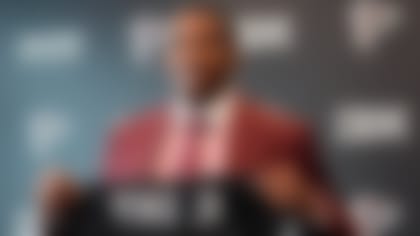After breaking down all the winners and losers from Day 1 and Day 2, let's wrap up the 2019 NFL Draft with a look at which groups across the league have improved the most.
Cardinals' passing game: All of the focus on the Josh Rosen saga took some attention away from the fascinating overhaul of Arizona's offense. Whether they succeed or not, Kliff Kingsbury's crew should transform from the worst unit in football to one of the groups I'm most excited to watch in 2019.
There simply hasn't been a prospect quite like No. 1 overall pick Kyler Murray to come along before, especially one that will enter the league with a coach even more aggressive than he is. Kingsbury's spread attack and Murray's combination of arm strength and running ability should provide a great preview of where the NFL is going over the next decade.
Second-round pick Andy Isabella, taken with a choice (No. 62 overall) acquired from the Dolphins in exchange for Rosen, profiles as a Brandin Cooks-like addition to the offense. Monstrous fourth-rounder Hakeem Butler (No. 103 overall) was viewed as a top-20 player by some draft analysts because of his physicality and deep-ball potential. Adding these two receivers to a corps featuring Larry Fitzgerald and second-year pro Christian Kirk gives Murray and Kingsbury a chance to hit the ground running offensively in September, provided the line can hold up. (The presence of star runner David Johnson should make that easier.) If the bold makeover pans out, pairing Kingsbury and Murray together could prove to be a move that was ahead of its time.
Eagles' offensive depth:The potential trade of slot receiver Nelson Agholor never materialized. Instead of parting ways with a piece, the Eagles only added to their offensive arsenal with second-round picks Miles Sanders (No. 53 overall), a running back, and J.J. Arcega-Whiteside (No. 57 overall), a wideout. Sanders has a chance to end March trade acquisitionJordan Howard's run as the Eagles' starting running back before it even begins, while Arcega-Whiteside adds another possession threat for Carson Wentz to find in tight quarters.
The depth at running back, wide receiver and tight end (where Zach Ertz and Dallas Goedert comprise the best duo in football) should give coach Doug Pederson a ton of play-calling options in the fall. Even the team's first-round selection (tackle Andre Dillard, No. 22 overall) was typical of the long-term thinking the Eagles are known for because he likely will begin his career on the bench behind Jason Peters. This is a group built to withstand injuries and create matchup problems in nearly any situation.
Chargers' defense: The Chargers are my early favorites in the clubhouse for AFC team most likely to win 12 games or more this season. Considering they won 12 a year ago, this shouldn't be that hot a take. Part of my confidence comes from this draft, where general manager Tom Telesco filled the biggest holes on his defensive depth chart with quality options.
Jerry Tillery (No. 28 overall) from Notre Dame slots right in as a 3-technique defensive tackle next to veteran Brandon Mebane. Delaware safety Nasir Adderley (No. 60 overall) is an excellent complement for last year's Defensive Rookie of the Year runner-up, Derwin James. While the right side of the offensive line remains a concern, defensive coordinator Gus Bradley has no excuse but to dominate with the group Telesco has put together.
Falcons' offensive line: It's safe to say the Falcons believe their 2018 season was doomed by their offensive line, not just poor injury luck. After spending mid-tier money on a trio of free agents (Jamon Brown, Ty Sambrailo and James Carpenter), the Falcons doubled down with two first-round picks: guard Chris Lindstrom (No. 14 overall) and right tackle Kaleb McGary (No. 31 overall). The Falcons traded up for McGary, possibly believing that he was a favorite of the Patriots, who held the 32nd overall pick, in the first round.
All of this investment in one area puts pressure on new offensive coordinator Dirk Koetter to turn the unit around in a hurry, which is great news for Matt Ryan and running back Devonta Freeman. It's as if GM Thomas Dimitroff is saying this is a Super Bowl roster, provided he can just get the line right.
Ravens' wide receivers: Eric DeCosta entered his first draft as GM knowing he needed wideouts. He found the perfect option for his offense after trading down in the first round, landing Marquise Brown 25th overall, and he grabbed a high-ceiling third-round pick in Notre Dame's Miles Boykin (No. 93 overall).
In the case of both players, the Ravens found explosive athletes who can get behind the defense and create plays on their own after the catch. Quarterback Lamar Jackson showed a better deep ball in college than he did as an NFL rookie last season, and both of these pickups play to that strength. Throw in fourth-round running back Justice Hill from Oklahoma State (No. 113 overall), and the Ravens added a trio of players who can take it the distance on any play -- just like their quarterback.
Buccaneers' defense: For as much grief as quarterback Jameis Winston has gotten during his time in Tampa, Mike Smith's defense was a far bigger problem throughout the three-season Dirk Koetter era. GM Jason Licht's first draft with coach Bruce Arians at the helm reflects that.
Tampa's first five picks, spread over the first four rounds, were all on the defensive side of the ball. LSU's Devin White (No. 5 overall) will join Lavonte David to comprise one of the fastest linebacker duos in the league. The Bucs loaded up in the secondary with two cornerbacks (Sean Bunting, No. 39 overall, and Jamel Dean, No. 94 overall) and a safety (Mike Edwards, No. 99 overall) in Rounds 2 and 3, then a defensive end (Anthony Nelson, No. 107 overall) in Round 4. This isn't the first time Licht has gone heavy on defense, of course, and his previous efforts failed. But this is the clearest sign yet that Arians believes he has the talent to win big now on offense, provided the defense can hold up. Former Jets coach Todd Bowles, now the Bucs' defensive coordinator, has a great chance to rebuild his coaching stock after being fired in New York, because this group already had talented players (David, Jason Pierre-Paul, Vita Vea and Gerald McCoy) before this draft.
Patriots' offensive physicality: While the rest of the league spreads out, it sure appears that the Patriots' offense is condensing. They enjoyed a great run late last season by leaning on their diverse running game. Surprise third-round running back Damien Harris (No. 87 overall) gives New England yet another backfield option. A rugged starter at Alabama over Raiders first-round pick Josh Jacobs, Harris will join Sony Michel, James White and Rex Burkhead (for now) in a group with a lot of different flavors.
The team's first-round pick, receiver N'Keal Harry (No. 32 overall), also was a surprise, because the Patriots have never drafted a receiver that early in the Bill Belichick era, much less a physical, outside option. Harry should gobble up some of Rob Gronkowski's red-zone targets in the wake of Gronkowski's retirement, and he's capable of lining up in a variety of spots. He fits on an offense that is increasingly leaning on physicality to complement Tom Brady.
Follow Gregg Rosenthal on Twitter @greggrosenthal.












